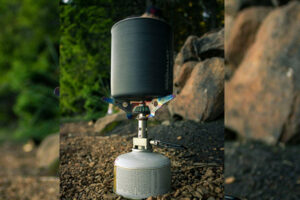Are you having trouble disconnecting a gas stove? Here’s a short guide on how to do it the right way. Disconnecting gas ranges may be difficult, but it is still a task that can be completed. Whether you want to detach your gas stove to give it a complete cleaning, repair a faulty hose connector, or replace the entire appliance. You can do it all on your own without spending any money.
Tools
Before you begin, you’ll need a few essential items from your local hardware shop.
- Two protective boards: optimally 2 pieces of Masonite, 2X4, 1/8” thick each
- An adjustable wrench 10″ or larger
Optional:
- 2 extra Masonite boards if you want to move the stove more than 4′ from its current location
- A second pipe wrench if you want to repair or reconnect your flex pipe
- Pipe thread sealant if you want to replace or reattach your flex pipe
Step-By-Step Guide
Follow these 5 direct steps to safely disconnect your gas stove with ease.
Place The Masonite Under the Stove Legs
Masonite is a type of engineered wood made from several fibers, comparable to particleboard, plywood, and medium-density fiberboard. It is a form of high-density fiberboard (HDF) that has been firmly compressed using a wet process, resulting in a light, somewhat flexible, and adaptable material. Take out your Masonite board. One side should be smooth, while the other should be felt-like. To avoid scratching their floors, all homeowners should wipe off the board and position the felt/rough side on the ground in front of their gas burners. Because the boards are often offered in 2X4 sizes, you will need two to cover the width of your stove. Slide the boards under the legs of the stove one at a time, carefully raising the stove with your arms and pushing the boards behind the front legs of the stove with your feet. One of the boards will slightly overlap the other.
Move Your Stove Outward
To acquire a solid grip on the appliance, open the oven door slightly and reach inside the oven and under the cooktop. Lift the oven and carefully move it outwards. If you have back problems or are in poor health, have a friend or family member do this step for you. The oven should begin moving down the Masonite board at this point. It may be necessary to gently raise it in order for the back to catch along the board. When your oven passes over the Masonite boards, you will notice scratches; these scratches would have otherwise caused havoc on your kitchen floor.
Unplug The Range
Once the stove is sufficiently removed from the wall, step behind it and locate the socket into which it is plugged. Turn off the stove. If you want to be extra careful, turn off the power to your kitchen from the circuit breaker before proceeding.
Shutoff The Gas
Your stove should remain connected to the gas line through a flexible tubing that terminates near the gas shutdown valve. This tube is also known as a flexible tube, pipeline, flex hose, flexible line, or flexible gas line. The valve is often red or yellow in color and resembles a valve used to switch on and off outdoor water hoses. Almost all state standards require gas shutdown valves to be positioned within 6 feet of your stove gas appliance. The valve in older buildings may be placed in the basement ceiling, beneath the floor, where your flex tubing joins the gas line in the wall. When you’ve found the valve, turn it 90 degrees perpendicular to turn off the gas. Some valves operate clockwise, while others operate counterclockwise. Gently spin the valve in both directions until you can turn it the appropriate distance – it should not allow rotations beyond 90 degrees. Return to your stove and try to light one of your burners to ensure that your gas is turned off. If you hear your burners clicking but they do not ignite, the gas has been effectively turned off.
Unscrew The Flex Pipe
Locate the point where the flex pipe from your stove links to the gas pipe supply coming from the wall. This is commonly a nut located just beneath or close to the gas valve.
Put your wrench on or near the nut to determine whether it needs to be adjusted. Adjust the wrench’s jaw size using the thumbscrew until it fits tightly around the nut. Position the wrench on the nut with the adjustable jaw facing you. Pull the wrench towards you to loosen the nut, then return to the same position and continue the process until the nut is entirely unscrewed and the flex pipe is free of the wall. When you first disconnect the gas connection, it is typical to smell natural gas. This gas had become trapped in the gas main line or flex tube and had to be released. During this period, do not start any fires near your kitchen.
If you still don’t understand the above steps, you can check out the video below:
KEY TAKEAWAYS
When it comes to removing your gas appliances, safety should always be your top priority. Here are some key steps to follow in order to safely disconnect and remove a gas appliance:
- When it comes to removing gas appliances, safety should always come first. The following are some important measures to take in order to properly disconnect and remove a gas appliance:
- Make sure the valve that controls the flow of gas to the appliance is closed to avoid any gas from leaking during the disconnecting procedure.
- Remove the supply hose from the appliance with care. This disconnects the appliance from the gas supply line.Depending on the kind of appliance, you need to disassemble burners and other gas-related components.
- When dealing with gas appliances, make sure your workspace is well-ventilated. This eliminates the possibility of accidental gas intake, which might pose major health hazards
Safety First: Key Steps
To ensure your safety while disconnecting your gas stove, follow these essential steps:
| Step | Action |
| 1. Turn Off the Gas Supply | Locate the main gas shutoff valve, usually near the gas meter. Turn the valve clockwise until it stops to completely shut off the gas supply. |
| 2. Open Stove Burners | After turning off the gas supply, open all the gas burners on your stove to release any residual gas. |
| 3. Check for Gas Leaks | Mix a solution of water and dish soap. Apply this mixture to the gas connections and pipes. Watch for bubbles, which indicate a gas leak. If you find any leaks, immediately tighten the connections or call a professional. |
FAQ
How to disassemble a gas stove for the first time?
Turn off the gas supply: Locate the main gas shutoff valve and turn it clockwise to the off position.
Open stove burners: Open all gas burners to release any residual gas.
Check for gas leaks: Use a soapy water solution to check for gas leaks around connections. Bubbles indicate a leak. If you find any, do not proceed and call a professional.
How to reassemble a gas stove after disassembly?
1. Reinstall internal components: Replace burners, igniters, and other components in their original positions, ensure all connections are secure.
2. Replace the cooktop: Align the cooktop with the stove base.
3. Reconnect electrical components: Carefully reconnect any electrical wires to the control panel or other components. Ensure proper connections to avoid electrical issues.
4. Reinstall the control panel: Align the control panel and secure it with screws.
5. Replace burner caps and grates: Place burner caps and grates back in their original positions.
6. Test the stove: Light all burners to ensure proper operation. Check for gas leaks around connections.
Important Considerations:
If you encounter difficulties during reassembly, consult a professional. Improper reassembly can lead to serious safety hazards. If you are unsure about any step, seek professional assistance.
What Tools needed to disassemble a gas stove?
Basic Tools:
1. Screwdrivers: Both Phillips head and flathead.
2. Wrenches: Adjustable wrenches or a set of combination wrenches.
3. Pliers: Needle-nose pliers can be useful for gripping small parts.
4. Putty knife: For gently prying apart components.
Additional Tools (Depending on the Stove):
1. Socket wrench set, Torx bit set, Allen wrench set.
2. Safety Equipment: Protective gloves, Safety glasses.
How long does it take to reassemble a gas stove?
Generally, for a simple disassembly and reassembly without any major repairs, it might take anywhere from 30 minutes to an hour. However, if you’ve replaced parts, cleaned components thoroughly, or are unfamiliar with the stove’s internals, it could take significantly longer.
Conclusion
After reading this guide, you should be able to safely and securely disconnect your gas stove. Working with gas appliances may be risky, especially if you’re unfamiliar with the technique. If you are ever confused or uncomfortable handling gas appliances, calling a professional is always the best option.
Disassembling a gas stove can be risky. If you’re unsure about any step, consult a professional appliance repair technician!






